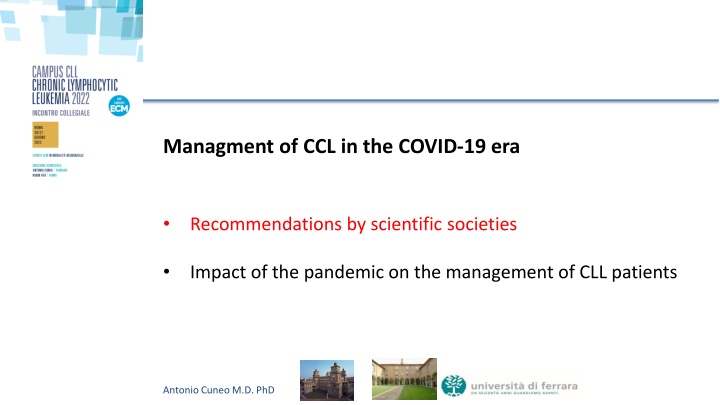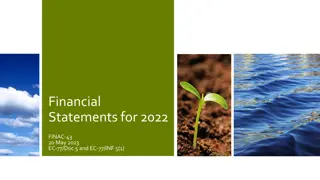
Managing Chronic Lymphocytic Leukemia (CLL) During the COVID-19 Pandemic
Explore recommendations by scientific societies on managing CLL patients during the COVID-19 era. Learn about the impact of the pandemic on CLL treatment approaches, including the importance of postponing treatment if possible, offering optimal therapy when necessary, and minimizing clinic visits. Considerations for using specific treatments like monoclonal antibodies and venetoclax are also discussed in relation to COVID-19 circumstances.
Download Presentation

Please find below an Image/Link to download the presentation.
The content on the website is provided AS IS for your information and personal use only. It may not be sold, licensed, or shared on other websites without obtaining consent from the author. If you encounter any issues during the download, it is possible that the publisher has removed the file from their server.
You are allowed to download the files provided on this website for personal or commercial use, subject to the condition that they are used lawfully. All files are the property of their respective owners.
The content on the website is provided AS IS for your information and personal use only. It may not be sold, licensed, or shared on other websites without obtaining consent from the author.
E N D
Presentation Transcript
Managment of CCL in the COVID-19 era Recommendations by scientific societies Impact of the pandemic on the management of CLL patients Antonio Cuneo M.D. PhD
COVID-19 and Chronic Lymphocytic Leukemia (Version 4.1; last updated February 2, 2021) Postpone treatment if possible If immediate therapy is required offer the best treatment option If possible, give the treatments that require fewer clinic visits Try to avoid or skip treatment with monoclonal antibodies (rituximab, obinutuzumab) especially when given in combination with targeted agents Venetoclax requires multiple and extended clinic visits with lab testing and should be avoided if possible unless considered the most appropriate treatment for a particular patient Approach to treatment initiation (active COVID-19) Approach to treatment initiation (pandemic under control) https://www.hematology.org/covid-19/covid-19-and-cll Input from Drs. Shadman M, Byrd J, Hallek M, Brown J, Hillmen P, Mato A, Ghia P * Ghia P and Rossi D, Hemasphere . 2020 Jul 30;4(4):e432
COVID-19 and Chronic Lymphocytic Leukemia (Version 4.1; last updated February 2, 2021) Approach to treatment initiation (active COVID-19) Approach to treatment initiation (pandemic under control) We follow standard treatment guidelines for CLL treatment and would not use COVID-19 as a factor in decision making. https://www.hematology.org/covid-19/covid-19-and-cll Input from Drs. Shadman M, Byrd J, Hallek M, Brown J, Hillmen P, Mato A, Ghia P * Ghia P and Rossi D, Hemasphere . 2020 Jul 30;4(4):e432
COVID-19 and Chronic Lymphocytic Leukemia (Version 4.1; last updated February 2, 2021) For outpatients with mild symptoms, we don t modify therapy. Change/modify therapy in CLL who develops COVID+? A decision regarding treatment modification in patients with more severe symptoms depends on weighing the aggressiveness of CLL versus the theoretical risk of more severe COVID complications https://www.hematology.org/covid-19/covid-19-and-cll Input from Drs. Shadman M, Byrd J, Hallek M, Brown J, Hillmen P, Mato A, Ghia P * Ghia P and Rossi D, Hemasphere . 2020 Jul 30;4(4):e432
COVID-19 and Chronic Lymphocytic Leukemia (Version 4.1; last updated February 2, 2021) Vaccine Primary and secondary immunodeficiencies involving adaptive immunity Splenectomy or functional asplenia B-cell directed therapies (e.g., blocking monoclonal antibodies against CD20 or CD22, bispecific agents like blinatumomab, CD19- or CD22-directed chimeric antigen receptor T cell [CAR-T] therapies, Bruton tyrosine kinase [BTK] inhibitors) T-cell-directed therapies (e.g., calcineurin inhibitors, antithymocyte globulin, alemtuzumab) Many chemotherapy regimens High-dose corticosteroids (>2 mg/kg/d daily prednisone for greater than two weeks, or equivalent) Hematopoietic cell transplantation (HCT), especially within the first three to six months after autologous HCT and often longer after allogeneic HCT Underlying aberrant immunity (e.g., graft-vs.-host disease, graft rejection, absent or incomplete immune reconstitution, neutropenia ANC <500/ L, lymphopenia ALC <200/ L) Immunocompromised patient populations https://www.hematology.org/covid-19/covid-19-and-cll Input from Drs. Shadman M, Byrd J, Hallek M, Brown J, Hillmen P, Mato A, Ghia P * Ghia P and Rossi D, Hemasphere . 2020 Jul 30;4(4):e432
COVID-19 and Chronic Lymphocytic Leukemia (Version 4.1; last updated February 2, 2021) Should I give a SARS-CoV-2 vaccine to my patient with CLL/SLL? While the safety of vaccine for each patient should be assessed on a case-by- case basis depending on its reported side effects and patient s comorbidities, we would in general recommend it for patients with a CLL/SLL diagnosis. For more information about SARS-CoV-2 vaccines and immunocompromised patients A third (additional dose) and fourth (booster) dose of either of the mRNA vaccines have been approved by both the FDA and CDC for immunocompromised patients. Should I use serological testing to decide if my patient should receive the third vaccine dose? Serological testing before the third dose is not recommended at this time. The currently available assays are non-standardized, and the clinical thresholds of protection are not known. The third dose should be administered regardless of serological results or antibody levels if the patient meets eligibility criteria. https://www.hematology.org/covid-19/covid-19-and-cll Input from Drs. Shadman M, Byrd J, Hallek M, Brown J, Hillmen P, Mato A, Ghia P * Ghia P and Rossi D, Hemasphere . 2020 Jul 30;4(4):e432
COVID-19 and Chronic Lymphocytic Leukemia (Version 4.1; last updated February 2, 2021) Should patients with breakthrough infection receive the third dose? Although the safety of additional doses in patients with breakthrough infection is not known, a third additional dose or a booster dose (fourth dose) should be considered as per the CDC recommendations after patients recover from their infection. Specifically, patients who were within six months of HCT or CD-20 therapy at the time of the primary vaccine series should receive the third dose after a breakthrough infection. Are patients who received monoclonal antibody (mAb) for post- exposure prophylaxis eligible to receive the third dose of the vaccine? Yes, no deferral period is recommended after the mAb treatment. https://www.hematology.org/covid-19/covid-19-and-cll Input from Drs. Shadman M, Byrd J, Hallek M, Brown J, Hillmen P, Mato A, Ghia P * Ghia P and Rossi D, Hemasphere . 2020 Jul 30;4(4):e432
Managment of CCL in the COVID-19 era Recommendations by scientific societies Impact of the pandemic on the management of CLL patients Antonio Cuneo M.D. PhD
CHRONIC LYMPHOCYTIC LEUKEMIA MANAGEMENT IN ITALY DURING THE COVID-19 PANDEMIC. A CAMPUS CLL REPORT Questionnaire to 33 centers* in Italy during the first week of April Strategy for testing by nasopharyngeal swab Impact of the Covid-19 outbreak in the diagnosis, management and outcome of CLL patients Impact on adherence to clinical protocols *Con il contributo di: Ilaria Angeletti, Federico Chiurazzi, Giovanni Del Poeta, Lorenzo De Paoli, Maria Rosaria De Paolis, Enrico Derenzini, Lucia Farina, Angela Ferrari, Massimo Gentile, Daniela Gottardi, Alessandro Gozzetti, Adalberto Ibatici , Monica Leone, Luciano Levato, Monica Maccaferri, Lara Malerba, Monia Marchetti, Marina Motta, Roberta Murru, Laura Nocilli, Jacopo Olivieri, Lorella Orsucci, Daniela Pietrasanta, Francesca Maria Quaglia, Francesca Re, Gianluigi Reda, Gian Matteo Rigolin, Lydia Scarf , Vittorio Stefoni, Marzia Varettoni. Cuneo A, Scarfo L, Reda G, Varettoni M, Quaglia FM, Marchetti M, De Paoli L, Re F, Pietrasanta D, Rigolin GM, Orsucci L, Ibatici A, Gattei V, Mauro FR, Trentin L, Laurenti L, Marasca R, Fo R. Blood. 2020 Jun 19:blood.2020006854. doi: 10.1182/blood.2020006854. Online ahead of print
FIRST CLL CAMPUS SURVEY (2020) Cuneo A, Scarfo L, Reda G, Varettoni M, Quaglia FM, Marchetti M, De Paoli L, Re F, Pietrasanta D, Rigolin GM, Orsucci L, Ibatici A, Gattei V, Mauro FR, Trentin L, Laurenti L, Marasca R, Fo R. Blood. 2020 Jun 19:blood.2020006854. doi: 10.1182/blood.2020006854
FIRST CLL CAMPUS SURVEY (2020) *Con il contributo di: Ilaria Angeletti, Federico Chiurazzi, Giovanni Del Poeta, Lorenzo De Paoli, Maria Rosaria De Paolis, Enrico Derenzini, Lucia Farina, Angela Ferrari, Massimo Gentile, Daniela Gottardi, Alessandro Gozzetti, Adalberto Ibatici , Monica Leone, Luciano Levato, Monica Maccaferri, Lara Malerba, Monia Marchetti, Marina Motta, Roberta Murru, Laura Nocilli, Jacopo Olivieri, Lorella Orsucci, Daniela Pietrasanta, Francesca Maria Quaglia, Francesca Re, Gianluigi Reda, Gian Matteo Rigolin, Lydia Scarf , Vittorio Stefoni, Marzia Varettoni.
FIRST CLL CAMPUS SURVEY (2020) *Con il contributo di: Ilaria Angeletti, Federico Chiurazzi, Giovanni Del Poeta, Lorenzo De Paoli, Maria Rosaria De Paolis, Enrico Derenzini, Lucia Farina, Angela Ferrari, Massimo Gentile, Daniela Gottardi, Alessandro Gozzetti, Adalberto Ibatici , Monica Leone, Luciano Levato, Monica Maccaferri, Lara Malerba, Monia Marchetti, Marina Motta, Roberta Murru, Laura Nocilli, Jacopo Olivieri, Lorella Orsucci, Daniela Pietrasanta, Francesca Maria Quaglia, Francesca Re, Gianluigi Reda, Gian Matteo Rigolin, Lydia Scarf , Vittorio Stefoni, Marzia Varettoni.
FIRST CLL CAMPUS SURVEY (2020) *Con il contributo di: Ilaria Angeletti, Federico Chiurazzi, Giovanni Del Poeta, Lorenzo De Paoli, Maria Rosaria De Paolis, Enrico Derenzini, Lucia Farina, Angela Ferrari, Massimo Gentile, Daniela Gottardi, Alessandro Gozzetti, Adalberto Ibatici , Monica Leone, Luciano Levato, Monica Maccaferri, Lara Malerba, Monia Marchetti, Marina Motta, Roberta Murru, Laura Nocilli, Jacopo Olivieri, Lorella Orsucci, Daniela Pietrasanta, Francesca Maria Quaglia, Francesca Re, Gianluigi Reda, Gian Matteo Rigolin, Lydia Scarf , Vittorio Stefoni, Marzia Varettoni.
Clinical trials in April 2020 Enrollment of CLL patients in clinical trials (30 centers) 17% Continued without significant modifications Continued without significant modifications 33% We could not enroll patients because the CRO stopped accrual We could not enroll patients because the CRO stopped accrual 17% We reduced our accrual potential for patient s or phycician's choice We reduced our accrual potential for patient s or physician s choice 33% Problems in the follow-up of enrolled patients Problems in the follow-up of enrolled patients
SECOND CLL CAMPUS SURVEY (2021) Questionnaire to 47 centers* in Italy during in march 2021 To compare the incidence and outcome of COVID-19 infection during a one year of the pandemic To compare the evolution of treatment of CLL during a one year of the pandemic To obtain information on the vaccination program Cuneo A, Rigolin GM, Coscia M, Quaresmini G, Scarf L, Mauro FR, Motta M, Quaglia FM, Trentin L, Ferrario A, Laurenti L, Reda G, Ferrari A, Pietrasanta D, Sportoletti P, Re F, De Paoli L, Foglietta M, Giordano A, Marchetti M, Farina L, Del Poeta G, Varettoni M, Chiurazzi F, Marasca R, Malerba L, Ibatici A, Tisi MC, Stefoni V, Leone M, Barat C, Olivieri J, Murru R, Gentile M, Sanna A, Gozzetti A, Gattei V, Gottardi D, Derenzini E, Levato L, Orsucci L, Penna G, Chiarenza A, Fo R. Hematol Oncol. 2021 Oct;39:570-574.
SECOND CLL CAMPUS SURVEY (2021) Management of chronic lymphocytic leukemia in Italy during a one year of the COVID 19 pandemic and at the start of the vaccination program. A Campus CLL report 15.039 CLL cases followed at 47 hematology centers 12 month incidence of COVID-19 infection 3.3% Cuneo A, Rigolin GM, Coscia M, Quaresmini G, Scarf L, Mauro FR, Motta M, Quaglia FM, Trentin L, Ferrario A, Laurenti L, Reda G, Ferrari A, Pietrasanta D, Sportoletti P, Re F, De Paoli L, Foglietta M, Giordano A, Marchetti M, Farina L, Del Poeta G, Varettoni M, Chiurazzi F, Marasca R, Malerba L, Ibatici A, Tisi MC, Stefoni V, Leone M, Barat C, Olivieri J, Murru R, Gentile M, Sanna A, Gozzetti A, Gattei V, Gottardi D, Derenzini E, Levato L, Orsucci L, Penna G, Chiarenza A, Fo R. Hematol Oncol. 2021 Oct;39:570-574.
SURVEY (2021) DURING A ONE YEAR OF THE COVID-19 PANDEMIC Age of patients with COVID-19 infection by phase of the pandemic Question N. of patients (%) Total Phase 1 Phase 2 Phase 3 p Feb 2020 Jan 2021 494 Feb - May 2020 (%) 147 (29.7) Jun - Sep 2020 (%) 28 (5.7) Oct 20 Jan 2021 (%) 319 (64.6) N. of COVID-19+ CLL patients Age at COVID-19 infection <50 50-65 65-75 >75 26 (5.3) 144 (29.1) 171 (34.6) 153 (31.0) 3 (2.0) 48 (32.7) 47 (32.0) 49 (33.3) 0 (0) 12 (42.9) 10 (35.7) 6 (21.4) 23 (7.2) 84 (26.3) 114 (35.8) 98 (30.7) 0.075 No significant difference in age despite COVID-19 infection in our country affected the healthy younger population more frequently during the phase 3 (54.6% of the positive cases) than in the phase 1 (28.6%). Cuneo A at al , on behalf of the CLL CAMPUS. Hematol Oncol. 2021 Oct;39:570-574.
SURVEY (2021) DURING A ONE YEAR OF THE COVID-19 PANDEMIC N. of patients with COVID19 infection followed at home or requiring O2 support by phase of the pandemic Question N. of patients (%) Feb 2020 Jan 2021 (%) Feb - May 2020 (%) Jun - Sep 2020 (%) Oct 2020 Jan 2021 (%) p N. of COVID-19+ CLL patients 494 147 (29.7) 28 (5.7) 319 (64.6) N. of COVID-19+ CLL* Followed at home without O2 support Required non-invasive O2 support Required invasive O2 support 187 (39.5) 192 (40.5) 95 (20.0) 49 (33.8)* 65 (44.8) 31 (21.4) 17 (65.4) * 6 (23.1) 3 (11.5) 121 (39.9) 121 (39.9) 61 (20.2) 0.053 * Comparison between the summer period (phase 2) and phase 1 of the pandemic p = 0.0096 The implementation of outreach services with home care and mobile clinics probably allowed to release the pressure in hospitals without negatively impacting on survival, especially in the summer period when the low prevalence of the disease enabled an accurate home care follow up No difference in the % of severe disease in phase 1 vs phase 3 Cuneo A, on behalf of the CLL CAMPUS Hematol Oncol. 2021 Oct;39:570-574.
SECOND CLL CAMPUS SURVEY (2021) 122 out of 494 (25%) patients with CLL with COVID-19 infection died 35 % of deaths due to COVID-19 in the different phases of the pandemic 30 25 p: 0.180 20 Death rate (%) February - May 2020 15 44/147 June - September 2020 10 October 2020 January 2021 73/319 5 5/28 0 February - May 2020 June - September 2020 October 2020 January 2021 Cuneo A, on behalf of the CLL CAMPUS Hematol Oncol. 2021 Oct;39:570-574.
SECOND CLL CAMPUS SURVEY (2021) Questionnaire to 47 centers* in Italy during in march 2021 To compare the incidence and outcome of COVID-19 infection during a one year of the pandemic To compare the evolution of treatment of CLL during a one year of the pandemic To obtain information on the vaccination program Cuneo A, Rigolin GM, Coscia M, Quaresmini G, Scarf L, Mauro FR, Motta M, Quaglia FM, Trentin L, Ferrario A, Laurenti L, Reda G, Ferrari A, Pietrasanta D, Sportoletti P, Re F, De Paoli L, Foglietta M, Giordano A, Marchetti M, Farina L, Del Poeta G, Varettoni M, Chiurazzi F, Marasca R, Malerba L, Ibatici A, Tisi MC, Stefoni V, Leone M, Barat C, Olivieri J, Murru R, Gentile M, Sanna A, Gozzetti A, Gattei V, Gottardi D, Derenzini E, Levato L, Orsucci L, Penna G, Chiarenza A, Fo R. Hematol Oncol. 2021 Oct;39:570-574.
SURVEY (2021) DURING A ONE YEAR OF THE COVID-19 PANDEMIC Anti CLL treatment did not change over a one-year of the pandemic Question N. of patients (%) Feb 2020 Jan 21 (%) Feb - May 20 (%) Jun - Sep 20 (%) Oct 20 Jan 2021 (%) p Treatment at the time of COVID19 infection na ve pre-treated on treatment 236 (47.8) 104 (21.0) 154 (31.2) 62 (42.2) 37 (25.2) 48 (32.6) 17 (60.7) 7 (25.0) 4 (14.3) 157 (49.2) 60 (18.8) 102 (32.0) 0.138 Ongoing anti-CLL treatment at the time of COVID-19 infection CIT BTKi PI3KD V VR 23 (15.0) 82 (53.2) 8 (5.2) 27 (17.5) 14 (9.1) 6 (12.5) 22 (45.8) 4 (8.3) 14 (29.2) 2 (4.2) 1 (25.0) 1 (25.0) 0 1 (25.0) 1 (25.0) 16 (15.7) 59 (57.8) 4 (3.9) 12 (11.8) 11 (10.8) 0.155 Cuneo A, on behalf of the CLL CAMPUS Hematol Oncol. 2021 Oct;39:570-574.
SURVEY (2021) DURING A ONE YEAR OF THE COVID-19 PANDEMIC Temporary interruption of CLL treatment at the time of COVID-19 infection by treatment Question N. of patients (%) February 2020 January 2021 Phase 1(February - May 2020) (%) Phase 2 (June - September 2020) (%) Phase 3 (October 2020 January 2021) (%) p Anti-CLL treatment withheld because of COVID-19 infection (n. of patients/ therapy) CIT BTKi PI3KD V VR 22/23 (95.6) 44/82 (53.6) 7/8 (87.5) 18/27 (66.6) 10/14 (71.4) 6/6 14/22 4/4 10/14 2/2 1/1 0/1 0 1/1 1/1 15/16 30/59 3/4 7/12 7/11 0.395 p=0.003 for the probability to withhold therapy by treatment Cuneo A, on behalf of the CLL CAMPUS Hematol Oncol. 2021 Oct;39:570-574.
Vaccination policy in the Campus CLL centers Question: would you recommend to withhold anti CLL treatment before and after vaccination to ensure a better immunization? Cuneo A et al on behalf of the Campus CLL. Hematol Oncol. 2021 Oct;39(4):570-574.
Managment of CCL in the COVID-19 era Recommendations by scientific societies Impact of the pandemic on the management of CLL patients A new scenario in 2022 Antonio Cuneo M.D. PhD
Pooled antibody response rates across subgroups in 6516 patients with hematologic malignancies
Mo Abs and anti-viral agents for the prevention and early treatment of COVID-19 % Reduction severe or symptomatic disease remdesivir molnupiravir paxolovid tixagevimab e cilgavimab 89% 87% 77% 50% remdesivir molnupiravir paxolovid tixagevimab e cilgavimab Gottlieb RL, N Engl J Med. 2022 Jan 27;386(4):305-315 Jayk BA. N Engl J Med. 2022 Feb 10;386(6):509-520. Hammnod J. N Engl J Med 2022;386:1397-408. Levin MJ. N Engl J Med April 20, 2022, at NEJM.org [epub ahead of print]
Clinical management approach to COVID-19 based on disease phase and severity 4 2 1 3 Modified from: Bae EY, at al Current Infectious Disease Reports (2021) 23: 28 27 Your Company Name Here
Antibody evasion properties of SARS-CoV-2 Omicron sublineages Pseudovirus neutralization by monoclonal antibodies (mAbs) Values above the limit of detection (LOD) of 10 g ml 1 (dotted line) are arbitrarily plotted to allow for visualization of each sample. COV2-2130 (cilgavimab) and its combination with COV2-2196 (tixagevimab) retained activity against BA.2 Iketani S et al Nature | Vol 604 | 21 April 2022 | 553
Further antibody escape by Omicron BA.4 and BA.5 from vaccine and BA.1 serum For AZD1061, activity to BA.4/5 was similar to BA.2 (< 2-fold reduction) The activity of the combination of both antibodies in AZD7442 (Dong et al., 2021) was reduced 8.1-fold compared with BA.2. Tuekprakhon A et al bioRxiv preprint doi: https://doi.org/10.1101/2022.05.21.492554; this version posted May 23, 2022
Incidence and severity of COVID-19 infection in patients with chronic lymphocytic leukemia who received pre-exposure prophylaxis with Tixagevimab and Cilgavimab in Italy: an observational case control study by the GIMEMA WP on chronic lymphoproliferative disorders AIFA criteria CLL patients Serology Negative or not done Positive No passive prophylaxis with Mo Abs Tixagevimab and Cilgavimab N of symptomtic COVID disease N of severe COVID disease N of COVID-related deaths
Conclusion - Expert opinions (ASH EHA): consider and adapt to the single patient - Management in Italy in 2022: towards normalization - COVID-19+ve CLL: no impact on outcome of previous or ongoing treatment for CLL has been so far convincingly documented - A new era for the management of COVID-19 in CLL has begun Vaccination No or sub-optimal immunization after vaccine in CLL under treatment or in progression Passive immunization Early administration of MoAbs in patients with symptomatic COVID Early administration of antiviral agents in patients with symptomatic COVID




















